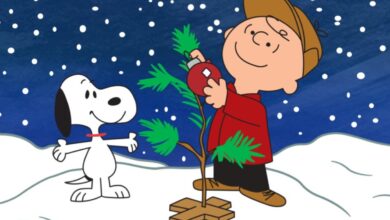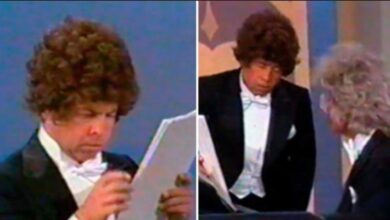Bee Gees’ ‘For Whom the Bell Tolls’ Marks a Triumphant Reinvention in 1993, Bridging Generations with Emotion and Elegance
In 1993, the Bee Gees stunned critics and fans alike with the release of For Whom the Bell Tolls, a soul-stirring ballad that proved their songwriting genius was far from a relic of the disco era. Released as the second single from their album Size Isn’t Everything, the track soared to No. 4 on the UK Singles Chart, making it their highest-charting UK single of the decade. While it may not have made the same impact on the U.S. Billboard Hot 100, it signaled something even more enduring: the Bee Gees’ remarkable ability to evolve, adapt, and deeply move audiences in any era.
By the early 1990s, the Bee Gees—brothers Barry, Robin, and Maurice Gibb—were already legends. Born on the Isle of Man and raised in Manchester before relocating to Australia, they had conquered the 1960s with their baroque-pop harmonies, the 1970s with their disco dominance, and the 1980s with reflective adult contemporary ballads. What set the Gibb brothers apart wasn’t just their harmony or songwriting—it was their resilience. They had weathered shifting public tastes, personal loss, and the rise and fall of entire musical movements, emerging each time with something that sounded both timeless and new.
For Whom the Bell Tolls was written during a period of renewed artistic focus for the group. The song’s title was a nod to Ernest Hemingway’s novel, but its lyrics were deeply personal—meditating on lost love, emotional paralysis, and the haunting echo of regret. Robin Gibb takes lead vocals with aching sincerity, delivering lines like “I stumble and fall, I’m crying out loud,” with a vulnerability that cuts to the bone. The song wasn’t just another ballad—it was a masterclass in restraint and raw emotion, capturing the weary introspection that comes with age and experience.
Produced by Barry Gibb and Femi Jiya, the song’s arrangement was deliberately lush yet understated. A rich string section gives the track a cinematic depth, while the brothers’ signature harmonies drift in and out like memories. The instrumentation is anchored by subtle percussion and piano, allowing Robin’s voice to shine unencumbered. There’s no excess here—every note feels intentional, reinforcing the track’s emotional gravity.
Critically, the song received widespread acclaim in the UK and Europe, with many praising it as one of their most mature compositions. Its chart success in the UK, where it remained in the Top 10 for several weeks, underscored the public’s deep connection to the Bee Gees’ more introspective work. Unlike their previous singles from the ’80s, which sometimes struggled for attention, For Whom the Bell Tolls found its audience immediately and stayed with them.
In a cultural landscape dominated by grunge and Britpop, the success of For Whom the Bell Tolls was both surprising and profound. It demonstrated that while musical trends may shift, emotional honesty never goes out of style. The Bee Gees didn’t attempt to chase modern sounds—they doubled down on what they did best: storytelling through harmony. In doing so, they bridged a generational gap, winning over longtime fans while earning the respect of younger listeners and critics alike.
The song also marked a turning point in the Bee Gees’ 1990s resurgence. Following the moderate success of their 1989 album One, Size Isn’t Everything reestablished the trio as vital songwriters in a decade where their legacy could have easily slipped into nostalgia. The success of For Whom the Bell Tolls led to renewed international touring and set the stage for their later studio efforts, including Still Waters in 1997, which would further solidify their staying power.
Its emotional tone and orchestral arrangement would go on to influence a number of artists exploring the intersection of pop and adult contemporary. The track’s success reminded producers and musicians alike that a ballad could still dominate charts if it spoke to real, lived experience. It quietly helped shape the ’90s revival of lush, melody-driven ballads that would resurface in acts like Savage Garden and even Coldplay’s early catalog.
Though not covered as widely as some of their earlier hits, For Whom the Bell Tolls has been revisited by fans and tribute artists for its poignant vocal performance and mature lyrics. The song’s elegant simplicity makes it a favorite among Bee Gees purists, and its subtle drama lends itself well to acoustic and orchestral interpretations. In live performances, the track was often used as a moment of pause—a way to bring intimacy to arenas otherwise filled with disco-era exuberance.
At the time of the song’s release, the Gibb brothers were navigating complex personal challenges. Maurice, in particular, had begun speaking openly about his struggles with alcoholism. The song, while not autobiographical, carried the weight of men who had lived through decades of fame, loss, and redemption. In many ways, For Whom the Bell Tolls became a quiet anthem for those silently bearing emotional burdens.
In the decades since its release, For Whom the Bell Tolls has only grown in stature. It’s regularly cited in retrospectives as one of the Bee Gees’ most emotionally resonant tracks. While Stayin’ Alive and How Deep Is Your Love may define their cultural peak, For Whom the Bell Tolls represents their artistic maturity—proof that their genius was never limited to dance floors.
Its influence can also be felt in how it shifted the Bee Gees’ public image in the 1990s. They were no longer just disco icons—they were elder statesmen of pop, capable of profound insight and gentle melancholy. This song played a key role in that transformation, reminding the world that the Gibb brothers were storytellers first and foremost.
In 2003, following Maurice’s untimely death, the song took on even deeper meaning for fans. Lines about loss and isolation felt eerily prescient, and it quickly became one of the most-requested tracks in tribute specials and memorial playlists. It remains a cornerstone of any serious retrospective on the Bee Gees’ enduring contribution to music.
Ultimately, For Whom the Bell Tolls stands as a powerful testament to the Bee Gees’ unmatched versatility. It wasn’t their most famous hit, but it may be their most emotionally complex. In a career defined by reinvention, this track revealed a quiet depth, inviting listeners to feel rather than dance—and in doing so, it cemented the group’s place not just in pop history, but in the hearts of those who still seek truth in melody.





